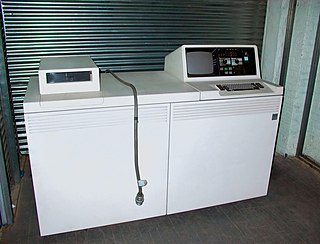
Fortran is a general-purpose, compiled imperative programming language that is especially suited to numeric computation and scientific computing.

In computing, a linker or link editor is a computer system program that takes one or more object files and combines them into a single executable file, library file, or another "object" file.
Portable Document Format (PDF) is a file format developed by Adobe in 1993 to present documents, including text formatting and images, in a manner independent of application software, hardware, and operating systems. Based on the PostScript language, each PDF file encapsulates a complete description of a fixed-layout flat document, including the text, fonts, vector graphics, raster images and other information needed to display it.

Transaction Processing Facility (TPF) is an IBM real-time operating system for mainframe computers descended from the IBM System/360 family, including zSeries and System z9.

The IBM System i is a midrange computer platform from IBM, sometimes referred to generically by the umbrella term AS/400 or "AS400". The platform was first introduced as the AS/400 in June 1988, with the operating system being called OS/400. In 2000, IBM introduced the eServer iSeries. As part of IBM's re-branding initiative in 2006, it was again renamed to System i.
Bytecode, also termed portable code or p-code, is a form of instruction set designed for efficient execution by a software interpreter. Unlike human-readable source code, bytecodes are compact numeric codes, constants, and references that encode the result of compiler parsing and performing semantic analysis of things like type, scope, and nesting depths of program objects.

In computer science, a library is a collection of non-volatile resources used by computer programs, often for software development. These may include configuration data, documentation, help data, message templates, pre-written code and subroutines, classes, values or type specifications. In IBM's OS/360 and its successors they are referred to as partitioned data sets.

The IBM System/34 was an IBM midrange computer introduced in 1977. It was withdrawn from marketing in February 1985. It was a multi-user, multi-tasking successor to the single-user System/32. Most notably, it included two very different processors, one based on System/32 and the second based on older System/3. Like the System/32 and the System/3, the System/34 was primarily programmed in the RPG II language.

The IBM System/36 was a small computer system marketed by IBM from 1983 to 2000 - a multi-user, multi-tasking successor to the System/34.

The System/38 is a discontinued minicomputer and midrange computer server platform manufactured and sold by the IBM Corporation. IBM announced the System/38 in 1978. The System/38 has 48-bit addressing, which was unique for the time, and a novel integrated database system. It was oriented toward a multi-user system environment. At the time, the typical system handled from a dozen to several dozen terminals.
An object file is a computer file containing object code, that is, machine code output of an assembler or compiler. The object code is usually relocatable, and not usually directly executable. There are various formats for object files, and the same machine code can be packaged in different object file formats. An object file may also work like a shared library.
RPG II is a very early and popular version of the IBM RPG programming language.
On many computing platforms everything is a file, but in contrast on the AS/400 everything is an object.
RPG is a modern proprietary high-level programming language (HLL) for business applications, popular on the IBM i operating system on IBM Power Systems hardware. The current version, RPG IV, a.k.a. ILE RPG, provides a modern programming environment. IBM has evolved the language, providing new capabilities, to take advantage of technologies that have grown up in the marketplace.
In computer programming, an entry point is where the first instructions of a program are executed, and where the program has access to command line arguments.
Dynamic-link library (DLL) is Microsoft's implementation of the shared library concept in the Microsoft Windows and OS/2 operating systems. These libraries usually have the file extension DLL, OCX, or DRV . The file formats for DLLs are the same as for Windows EXE files – that is, Portable Executable (PE) for 32-bit and 64-bit Windows, and New Executable (NE) for 16-bit Windows. As with EXEs, DLLs can contain code, data, and resources, in any combination.
Eagle Computer of Los Gatos, California, was an early microcomputer manufacturing company. Spun off from Audio-Visual Laboratories (AVL), it first sold a line of popular CP/M computers which were highly praised in the computer magazines of the day. After the IBM PC was launched, Eagle produced the Eagle 1600 series, which ran MS-DOS but were not true clones. When it became evident that the buying public wanted actual clones of the IBM PC, even if a non-clone had better features, Eagle responded with a line of clones, including a portable. The Eagle PCs were always rated highly in computer magazines.
System Support Program (SSP) was an operating system for the IBM System/34 and System/36 minicomputers. SSP was a command-based operating system released in 1977.
The OS/360 Object File Format is the standard object module file format for the IBM DOS/360, OS/360 and VM/370, Univac VS/9, and Fujitsu BS2000 mainframe operating systems. In the 1990s, the format was given an extension with the XSD-type record for the MVS Operating System to support longer module names in the C Programming Language. This format is still in use by the z/VSE operating system. In contrast, it has been superseded by the GOFF file format on the MVS Operating System and on the z/VM Operating System. Since the MVS and z/VM loaders will still handle this older format, some compilers have chosen to continue to produce this format instead of the newer GOFF format.
The GOFF specification was developed for IBM's MVS operating system to supersede the IBM OS/360 Object File Format to compensate for weaknesses in the older format.






